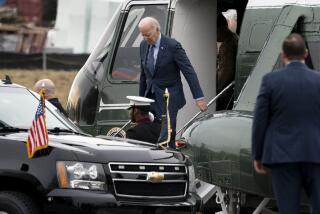Rare film depicts Franklin Roosevelt in wheelchair
- Share via
Drowsy from watching hours of unedited World War II film footage, Ray Begovich snapped to attention when one eight-second snippet flashed before him.
Begovich, a journalism professor at Franklin College in Indiana, was visiting the National Archives in College Park, Md., doing research for a biography on President Franklin Roosevelt’s director of war information.
The 16-millimeter film showed Roosevelt visiting the Navy’s U.S. heavy cruiser Baltimore on July 26, 1944.
FOR THE RECORD:
Roosevelt wheelchair: An article in the July 14 Section A about rare film footage showing President Franklin D. Roosevelt in a moving wheelchair said that President Clinton dedicated a statue in 2006 depicting Roosevelt in a wheelchair. The dedication ceremony was in 2001. —
Toward the end of the film, a photographer captured Roosevelt exiting a doorway down a ramp. The president moved in a gliding motion, the top of his head barely visible, as he was in a wheelchair.
Begovich was no Roosevelt scholar. But he knew what he was looking at had to be rare. No moving images of Roosevelt in his wheelchair were thought to exist -- due to a deliberate effort to conceal the president’s disability from the public during his lifetime.
Begovich watched the clip dozens of times before requesting a DVD copy. Over the next several years, he showed the footage to colleagues and experts, and conducted extensive online searches.
His hunch was right: The clip appears to be the only known footage of the president in his wheelchair to surface in the decades since Roosevelt’s death. Begovich kept largely quiet about his discovery until this week.
It is impossible to say whether it’s the earliest, or only, existing video footage of Roosevelt in a wheelchair, Laura Diachenko, a spokeswoman with the National Archives, told the Los Angeles Times. “But it’s definitely very rare,” she said.
In 1921, at age 39, Roosevelt contracted polio. The illness left him paralyzed below the waist.
At the time, people affected by polio were often kept out of sight. As Roosevelt advanced in his political career, he carefully concealed his condition from the public. He used leg braces, a cane or the help of a companion’s arm to walk short distances during public appearances.
Among journalists of the time, there was an unspoken rule: No one would photograph or record the president in a way that revealed the extent of his disability. That included photos of aides lifting him out of cars or carrying him into buildings, or of the president in a wheelchair. Secret Service agents were on hand to intervene if anyone failed to cooperate.
Begovich has a theory about who took the photograph -- he suspects a U.S. Navy photographer, impressed by a presidential visit to the base during wartime. The way the footage breaks away suggests the person filming knew it was taboo to do so, he said.
Just two weeks ago, the Franklin D. Roosevelt Presidential Library and Museum opened after a grand-scale remodeling. The new permanent exhibition at the museum addresses the subject of Roosevelt’s disability in more detail, exploring the impact of his paralysis on his personal and political life, said museum curator Herman Eberhardt.
Of the more than 10,000 still photographs in the museum collection, only four show Roosevelt in a wheelchair, Eberhardt said. He said the museum is talking about incorporating Begovich’s find into the exhibition.
Americans knew Roosevelt had contracted polio, Eberhardt said, but it is less clear how much was understood about the extent of his disability. Time magazine directly discussed it in an article published Feb. 1, 1932: “To this day, no one has ever heard him admit he could not walk. … Never have his crippled legs deterred him from going where he would.”
Roosevelt’s polio affliction became widely known and memorialized after his death. In 2006, President Clinton dedicated a statue of the president in his wheelchair at the entrance to the Franklin D. Roosevelt Memorial, between the Lincoln and Jefferson memorials in Washington.
Begovich said he hoped his accidental discovery would inspire scholars to look more intently for surviving film footage of Roosevelt -- and help bolster people with disabilities who want to seek political careers.
“I would love to see people running for office who use a wheelchair, guide dog or sign language,” Begovich said.
[For the record, 9:23 a.m. July 13: An earlier version of this post located Franklin College in Illinois. The school is in Indiana.]
ALSO:
Zimmerman defense stresses reasonable doubt to jurors
Mystery man at Seattle campus faces federal weapons charges
DNA ‘familiar match’ ties DeSalvo to 1964 Boston Strangler case
Twitter: @devckelly
More to Read
Sign up for Essential California
The most important California stories and recommendations in your inbox every morning.
You may occasionally receive promotional content from the Los Angeles Times.










